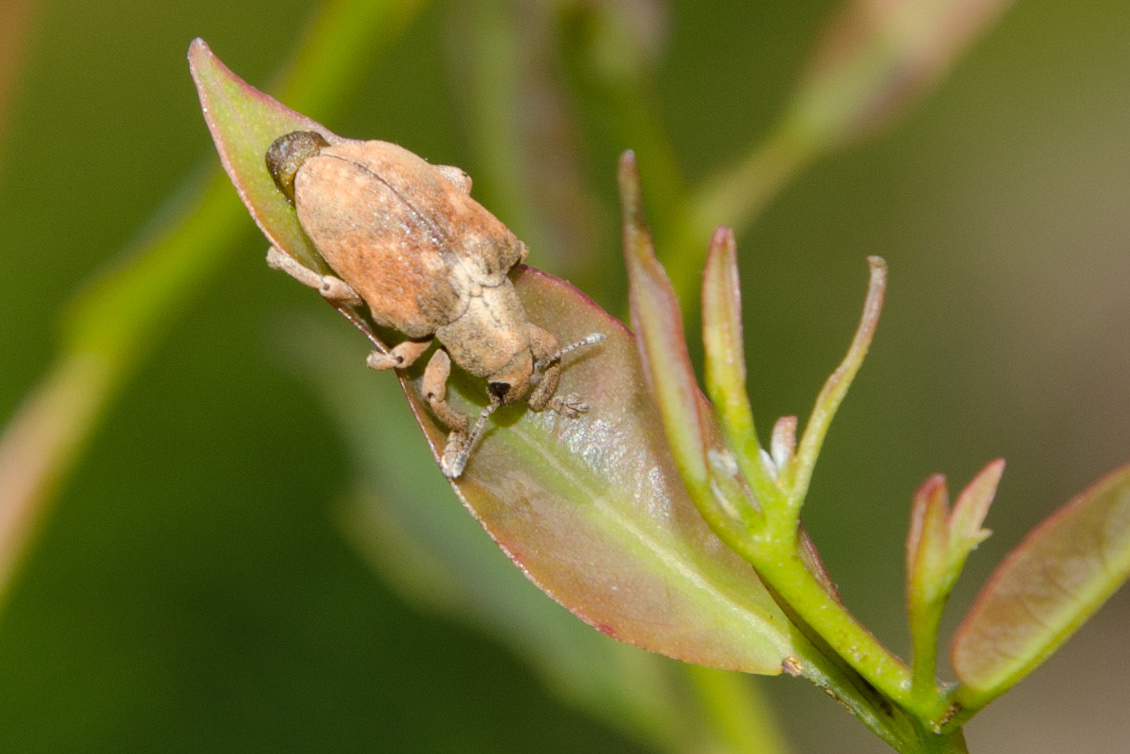Diversifying the biological control of Gonipterus sp. 2 in South Africa 2021-09-28
The Eucalyptus snout beetle, Gonipterus sp. 2, is an invasive insect native to Australia and a major defoliator of Eucalyptus. The pest has a long history of taxonomic confusion and was previously known as Gonipterus scutellatus. It is now known to be part of a cryptic species complex which comprises of at least eight different species, of which three species are invasive.
Management of Gonipterus spp. relies mainly on the use of classical biological control, by an egg parasitoid Anaphes nitens. A. nitens was introduced in South Africa in 1924. The pest was considered to be managed under economic threshold by 1950. The initial success of the project led to the release of A. nitens in the invaded range of Gonipterus sp.. Despite this initial success of the biological control program, outbreaks of the pest were still observed at high altitude regions in spring, possibly due to poor overwintering of A. nitens. Over time, Gonipterus outbreaks have also been observed in summer and in low altitude regions of South Africa where it was previously reported to be controlled. A more robust pest management strategy for Gonipterus sp. 2 in South Africa is thus needed to gain economic control of this pest.
A more robust pest management system can be achieved by increasing the diversity of biological control agents targeting different life stages of the pest. This can be achieved by releasing additional species of egg and larval parasitoids from the native range, increasing the genetic diversity of A. nitens, and investigating the use of entomopathogenic fungi and nematodes native to South Africa to target the larval and pupal stages of Gonipterus.
Recent surveys have revealed several species of egg and larval parasitoids to occur in the native range of the Gonipterus scutellatus species complex. Two egg parasitoid species, A. tasmaniae and A. inexpectatus have been released in Chile and Portugal respectively to control Gonipterus platensis. FABI investigated these two species as potential biological control agents of Gonipterus sp. 2. A. tasmania did not establish in culture in the FABI quarantine laboratory despite numerous attempts. A. inexpectatus was reared in the quarantine laboratory for multiple generations but did not show potential as a good biological control agent for Gonipterus sp. 2. These two species of egg parasitoids are not present within the native range of Gonipterus sp. n. 2 and it is likely that Goniperus sp. 2 is not an adequate host for these species.
Centrodora damoni, an egg parasitoid present within the native range of Gonipterus sp. 2. has been imported to the FABI quarantine laboratory. Little is known about the biology of this species, its interaction with other egg parasitoid species and its host range. An MSc student, Idea Makowe, is studying the biology of this species in the laboratory as the first step towards assessing its potential as a biological control agent for Gonipterus sp. 2. Further work will include studies on the interaction between C. damoni and A. nitens. If results from the biology studies indicate that C. damoni is a good biological control candidate, then host specificity studies will be needed before an application for its release can be submitted to the Department of Forestry, Fisheries and Environment.
Recent surveys revealed that A. nitens is present within the native range of Gonipterus sp. 2 and the distribution of these two species extend over a wide range of climatic regions in Australia. Climate matching of the pest and biocontrol agent can be an important factor in determining success of a biocontrol programme. Thus, regions in the native range of A. nitens that are climatically similar to regions of Gonipterus sp. 2 outbreaks in South Africa have been identified. The first shipment has been received and another planned for later this year. A PhD student, Harm Barten, is investigating the genetic diversity of A. nitens and studying the effect of hybridization between the South African and Australian population on fitness of A. nitens to gain insight in how the releases will influence the overall fitness of the biological control agent. Plans to release the new Australian populations of A. nitens in South Africa are underway.
Two strategies of biological control are being pursued to target the larval stage of Gonipterus sp. 2 in South Africa. A Tachinid fly from Tasmania, Agaonia cf. lasiopthalma, is a larval parasitoid of Gonipterus spp. and is being investigated in Portugal for its potential as a biological control agent. Through BiCEP we are discussing possibilities to import this species for evaluation, including suitability to Gonipterus sp. 2 and host specificity trials, in the quarantine laboratory of the FABI Biocontrol Centre. In addition, an MSc student, Marizanne Jones, is investigating the diversity of entomopathogenic fungi (EPF), focusing on Beauveria bassiana, in South African Eucalyptus plantations associated with Gonipterus sp. 2. She will also investigate the potential of the EPF isolates to be used as biopesticides against Gonipterus sp. 2 as part of an integrated pest management system.
The natural enemies that attack the pupal stage of Gonipterus sp. in the native range are not known. However, entomopathogenic nematodes (EPNs) have been reported to kill Gonipterus platensis pupae in Brazil. Thus, an MSc student, Innocent Rakubu, is investigating the potential of native EPN species as biological control agents to target the pupal stage ofGonipterus sp. 2.
The research at FABI to develop a diverse biological control program for Gonipterus sp. 2 is made possible through the collaboration with BiCEP and its members, and the support of industry partners and Forestry South Africa (FSA).






